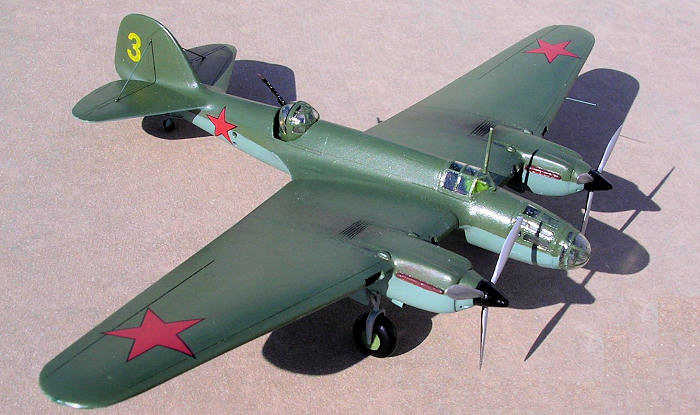
Pavla 1/72 Archangelskij Ar-2
| KIT #: | ? |
| PRICE: | $12.00 (must have been a while back. Ed) |
| DECALS: | One option |
| REVIEWER: | Carmel J. Attard |
| NOTES: | short run injected kit with brass etch detail parts and vacform clear parts. |

| HISTORY |
Way
back in 1941 during the early days of the war in the East, the Soviet Air Force
introduced the Pe-2 alongside the Ar-2 dive-bombers. The Ar-2 had been
development of the SB-2 bomber following the experience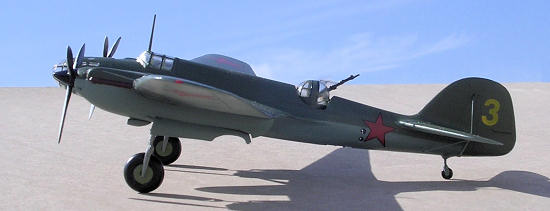 of the Spanish civil war of 1936-39 where the SB-2 fought on both fronts of the
war. The Ar-2 prototype was built in 1939 under the designation SB-RK as an
aerodynamically refined version of the SB-2 and SB-2 bis, and was powered by two
1,100 hp Klimov M-105R, 12-cylinder in-line engines. It carried a bomb load of
1,000 Kg and the defensive armament consisted of three 7.62mm SKAS machine guns.
The wing was provided with dive brakes similar to those mounted on the Pe-2.
Production of the Ar-2 started in 1940 and during 1941 200 aircraft were
delivered to combat units. Production of the faster Pe-2 started at the same
time resulting in that the Ar-2 saw only limited service. One of the limitations
of the original design seems to be the restricted fuel capacity.
of the Spanish civil war of 1936-39 where the SB-2 fought on both fronts of the
war. The Ar-2 prototype was built in 1939 under the designation SB-RK as an
aerodynamically refined version of the SB-2 and SB-2 bis, and was powered by two
1,100 hp Klimov M-105R, 12-cylinder in-line engines. It carried a bomb load of
1,000 Kg and the defensive armament consisted of three 7.62mm SKAS machine guns.
The wing was provided with dive brakes similar to those mounted on the Pe-2.
Production of the Ar-2 started in 1940 and during 1941 200 aircraft were
delivered to combat units. Production of the faster Pe-2 started at the same
time resulting in that the Ar-2 saw only limited service. One of the limitations
of the original design seems to be the restricted fuel capacity.
| THE KIT |
Perhaps
not the most exciting kit ever to appear in this line of Russian bombers and I
must admit that to me the Ar-2 was little known. There is a certain amount of
detail packed in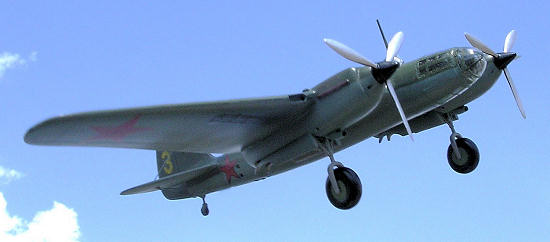 to
the model, from brass etch dive brakes to the accuracy detail of defensive gun
turret. The kit fits my range of scale at 1/72; it is molded in medium gray
plastic and has no guide pins just like any short run kits but still has a few
irritations. The kit does not provide injected items for the clear parts. All
the transparencies are vac form type and areas like the nose and gun turret
consist of two-piece part in each case, which takes time to trim and bring to
correct fitting size using a brand new sharp Exacto blade. I noted that it was
the nose perespex that needed a lot of time to make them fit. A number of dry
fittings with each case are recommended before the clear parts stand correctly.
Other than this the kit is not difficult to construct. Parts have well
restrained panel detail in very fine raised lines. The general fit of the parts
is very good and little filler being needed on my example.
to
the model, from brass etch dive brakes to the accuracy detail of defensive gun
turret. The kit fits my range of scale at 1/72; it is molded in medium gray
plastic and has no guide pins just like any short run kits but still has a few
irritations. The kit does not provide injected items for the clear parts. All
the transparencies are vac form type and areas like the nose and gun turret
consist of two-piece part in each case, which takes time to trim and bring to
correct fitting size using a brand new sharp Exacto blade. I noted that it was
the nose perespex that needed a lot of time to make them fit. A number of dry
fittings with each case are recommended before the clear parts stand correctly.
Other than this the kit is not difficult to construct. Parts have well
restrained panel detail in very fine raised lines. The general fit of the parts
is very good and little filler being needed on my example.
| CONSTRUCTION |
Construction starts with assembling the fuselage interior compartments, front
crew compartment and aft mid fuselage turret area but before starting there are
two port holes at the rear fuselage sides that need to be marked and drilled
forming two 3/16 round port holes, one on top of each other at both sides. The
cockpit detail consists of control wheel, pilot seat and straps; rudder pedals, floor and cockpit bulkheads and brass etch
instrument panel. The rear gun position is also enclosed between two
semi-bulkheads. This is also well-detailed area, which includes ammunition feed
belt to the rear gun. I painted all interiors in interior gray. The leading edge
wing parts also have filters in brass, which are fitted to the air intakes
preferably added before the wings are joined together. There is an appreciable
amount of detail to the wheel wells and there be no less that 16 pieces to go
together. Interior of undercarriage bays is medium gray and is best done before
the wings are joined together. Some care is required for the alignment of the
main wings and tail planes since these are butt jointed to the fuselage. The
only extra work needed to the kit is the rigging support to the tail fin and
rudder. Their position of the locating holes is given in mm. I made this out
of nylon thread, others may prefer to use steel wire string. As mentioned
earlier, trimming and assembling the clear parts can be time consuming but with
little extra effort that I am sure is not lacking with modelers, the correct fit
of these parts is managed. Once secured in place the clear parts are masked with
strips of Tamiya tape and white glue, ready for the paintwork.
pilot seat and straps; rudder pedals, floor and cockpit bulkheads and brass etch
instrument panel. The rear gun position is also enclosed between two
semi-bulkheads. This is also well-detailed area, which includes ammunition feed
belt to the rear gun. I painted all interiors in interior gray. The leading edge
wing parts also have filters in brass, which are fitted to the air intakes
preferably added before the wings are joined together. There is an appreciable
amount of detail to the wheel wells and there be no less that 16 pieces to go
together. Interior of undercarriage bays is medium gray and is best done before
the wings are joined together. Some care is required for the alignment of the
main wings and tail planes since these are butt jointed to the fuselage. The
only extra work needed to the kit is the rigging support to the tail fin and
rudder. Their position of the locating holes is given in mm. I made this out
of nylon thread, others may prefer to use steel wire string. As mentioned
earlier, trimming and assembling the clear parts can be time consuming but with
little extra effort that I am sure is not lacking with modelers, the correct fit
of these parts is managed. Once secured in place the clear parts are masked with
strips of Tamiya tape and white glue, ready for the paintwork.
| COLORS & MARKINGS |
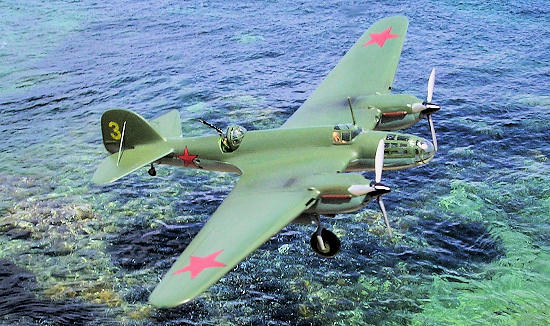 There is
little on offer in way of camouflage colors other than the finish in Russian
green FS34092 upper and light blue lower surfaces. Exhaust stacks are reddish
brown. Propeller is silver front of blade and matt black on the pressure side,
spinner black. Wheel hubs field green. The four small round portholes were
covered with Kristal Kleer. A coat of Klear was brushed on all surfaces and 6
star position decals applied, while a yellow identification number out of a
choice of three was attached to the rudder.
There is
little on offer in way of camouflage colors other than the finish in Russian
green FS34092 upper and light blue lower surfaces. Exhaust stacks are reddish
brown. Propeller is silver front of blade and matt black on the pressure side,
spinner black. Wheel hubs field green. The four small round portholes were
covered with Kristal Kleer. A coat of Klear was brushed on all surfaces and 6
star position decals applied, while a yellow identification number out of a
choice of three was attached to the rudder.
| CONCLUSIONS |
This is
not an aircraft that from the looks of it you can easily get hooked on. Maybe it
is little known due its limited service life or there is little on offer in way
of color schemes as it never went to Air Forces outside the Soviet Union, much
unlike its predecessor the SB2 where various camouflage liveries are available
when serving in Spain, China, Bulgaria or Czech AF. However the Ar-2 certainly
merits its place in the long line of Soviet aircraft that saw service during
WWII.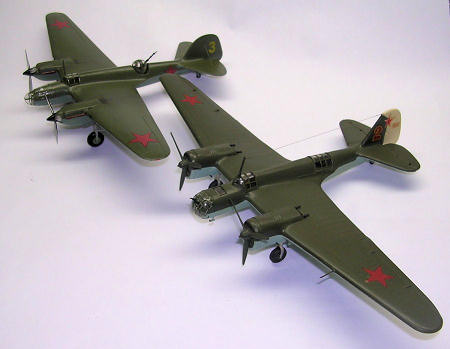
June 2010
If you would like your product reviewed fairly and quickly, please contact me or see other details in the Note to Contributors.